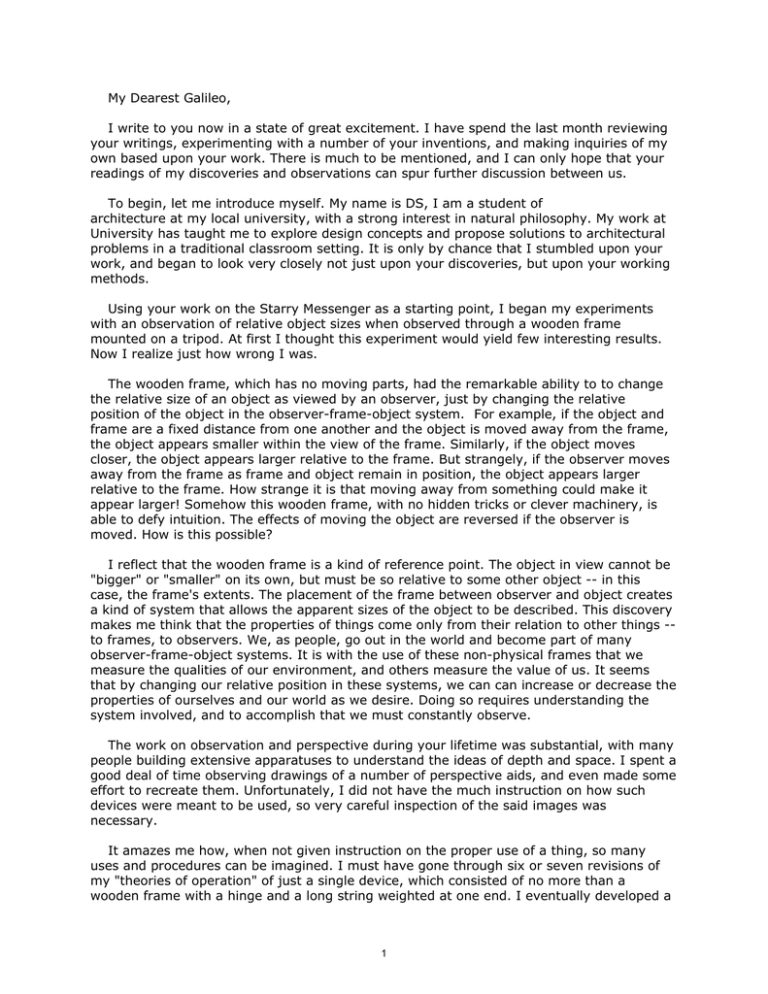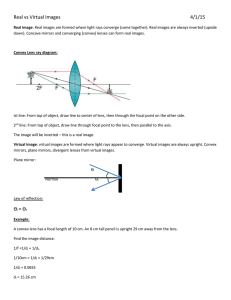My Dearest Galileo,
advertisement

My Dearest Galileo, I write to you now in a state of great excitement. I have spend the last month reviewing your writings, experimenting with a number of your inventions, and making inquiries of my own based upon your work. There is much to be mentioned, and I can only hope that your readings of my discoveries and observations can spur further discussion between us. To begin, let me introduce myself. My name is DS, I am a student of architecture at my local university, with a strong interest in natural philosophy. My work at University has taught me to explore design concepts and propose solutions to architectural problems in a traditional classroom setting. It is only by chance that I stumbled upon your work, and began to look very closely not just upon your discoveries, but upon your working methods. Using your work on the Starry Messenger as a starting point, I began my experiments with an observation of relative object sizes when observed through a wooden frame mounted on a tripod. At first I thought this experiment would yield few interesting results. Now I realize just how wrong I was. The wooden frame, which has no moving parts, had the remarkable ability to to change the relative size of an object as viewed by an observer, just by changing the relative position of the object in the observer-frame-object system. For example, if the object and frame are a fixed distance from one another and the object is moved away from the frame, the object appears smaller within the view of the frame. Similarly, if the object moves closer, the object appears larger relative to the frame. But strangely, if the observer moves away from the frame as frame and object remain in position, the object appears larger relative to the frame. How strange it is that moving away from something could make it appear larger! Somehow this wooden frame, with no hidden tricks or clever machinery, is able to defy intuition. The effects of moving the object are reversed if the observer is moved. How is this possible? I reflect that the wooden frame is a kind of reference point. The object in view cannot be "bigger" or "smaller" on its own, but must be so relative to some other object -- in this case, the frame's extents. The placement of the frame between observer and object creates a kind of system that allows the apparent sizes of the object to be described. This discovery makes me think that the properties of things come only from their relation to other things to frames, to observers. We, as people, go out in the world and become part of many observer-frame-object systems. It is with the use of these non-physical frames that we measure the qualities of our environment, and others measure the value of us. It seems that by changing our relative position in these systems, we can can increase or decrease the properties of ourselves and our world as we desire. Doing so requires understanding the system involved, and to accomplish that we must constantly observe. The work on observation and perspective during your lifetime was substantial, with many people building extensive apparatuses to understand the ideas of depth and space. I spent a good deal of time observing drawings of a number of perspective aids, and even made some effort to recreate them. Unfortunately, I did not have the much instruction on how such devices were meant to be used, so very careful inspection of the said images was necessary. It amazes me how, when not given instruction on the proper use of a thing, so many uses and procedures can be imagined. I must have gone through six or seven revisions of my "theories of operation" of just a single device, which consisted of no more than a wooden frame with a hinge and a long string weighted at one end. I eventually developed a 1 hypothesis that I found plausible -- that the string was effectively used as a sight for drawing -- but I did not have the opportunity to test my mock-up to determine its efficacy. Some days later, I began to explore lenses and mirrors. Lenses are perhaps some of the most interesting artifacts I have ever come across. There is not much to a lens as you know; it is simply a piece of shaped glass. But the specific shape and geometry of the glass creates all sorts of interesting and unusual properties. Like a frame, a lens has the ability to alter the perception of an object as seen through it, and it would seem that the specific shape of the lens determines how the object will be altered. Convex lenses appear to magnify objects viewed through them, while concave lenses appear to make objects appear farther away. Bi-convex lenses appear to work in a similar way to convex lenses -- shining light through them and on to a flat surface creates all sorts of unusual properties. For example, when an illuminated image is projected through a bi-convex lens onto a surface, the image appears magnified. However, if the surface is moved closer to the lens, all parts of the image appear to be condensed into a single beam. Move the surface away, and the image returns, until it goes out of focus and simply becomes diffused light. It's hard to understate the implications of this finding. It would seem that, given an appropriate orientation of bi-convex lens and image, it could be possible to take a large image or scene, which represents an enormous amount of information, and concentrate it down to a small region. If this region could then be transferred to some far-off place and then enlarged again, the possibility exists to have moving pictures or scenes sent across the world in an instant. Imagine that you and your collaborator, separated by many cities, could communicate in real time simply by sending the scene of yourselves through a network of lens pipelines spread across the landscape. The proposition obviously lies some ways off, but more research may make such an invention viable. Lenses do other strange things as well. A lens with one concave and one convex side, much like a fruit bowl, appears to make the same alteration to an image regardless of which way to orient yourself to it. Look through the concave side at an object, and the object appears smaller. Do the same with the convex side, and the object also appears smaller. How is it that the combination of a convex and concave lens, which have opposite properties on their own, could give identical behavior when put together? Noting these observations leads to an interesting question: what, exactly, is traveling through the lens to form the image on the other side? If I look through a lens, I see what is on the other side of the lens, albeit altered in some way. But what is doing the "traveling"? It can't be the object itself, or else it wouldn't appear altered. It is not the object, but it is similar to it, as the performance of a musical piece in a different key is like the original, but at the same time altered. Like the musical piece, the object must be transmitting some kind of general sense of itself, or the information that makes it what it is, so as my eyes may see it and I may know what it is. In all of my diagrams, I do not draw a representation of the information sent through the lens, but simply the path I believe it may be taking. My work with lenses brings forth an idea that continues to recur throughout my observations, namely, that configurations are important. It is not just the raw materials of a thing, whether it be a machine, a organism or a planet, that make it what it is, but the very specific way they are arranged. A metal screw and a metal spoon are both made of the same material, but it is their form that dictates their utility. It's interesting to note how just a single piece of material, like glass, can be remolded in so many ways to produce unusual and useful phenomena. I have found that, like you, I very much enjoy observing the world privately, noting my thoughts and observations in notebooks fully intending that I will be the only one to ever 2 read them. But I have also found that there is something to be said for working with others, for collaborating in one's observation and analysis of the natural world. Each observer will likely have his own perspective on a phenomena, and it is important to embrace these varying points of view. Critical discussion can, I think, help to narrow the gap between differing opinions on topics such as the nature of light or the behavior of natural oscillators, but lest we be too hasty to dismiss another experimenter's findings or viewpoint, we may miss valuable perspective in understanding the phenomena for ourselves. As a matter of advice, and having learned the hard way, I might encourage you to have a more thorough discussion with Johannes Kepler on your ideas. He clearly holds you in high respect, and an honest discussion of each other's individual work may be worthwhile. I can't pretend to have the talent or the patience to do work of your caliber, at least at the moment, but I am excited to begin making inquiries of my own. You and your work have inspired to go into the world, to observe and to ponder, without fear that I will not be able to understand. The world is a big place, and there are so many exciting things to discover for myself. Even if I only observe some very small part of it, it will be time well spent. Thank you, dearest Galileo, for opening my eyes, quieting my mind, and allowing me to be a true explorer. I will write again soon. Until then, all the best. Yours, DS 3 MIT OpenCourseWare http://ocw.mit.edu EC.050 Recreate Experiments from History: Inform the Future from the Past: Galileo January IAP 2010 For information about citing these materials or our Terms of Use, visit: http://ocw.mit.edu/terms.





